It is a truth universally acknowledged
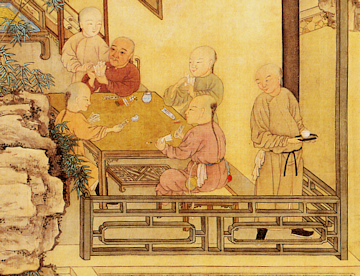
Chinese men playing cards, 18-19 century that playing-cards originated in China and were ancestral to those we know today.
But the standard story, as regurgitated many times on the internet, could well be wrong.
The story that cards were invented some time in the Tang Dynasty (618-907) is based on a number of literary references of the time to a game called yezi ge, "the game of Leaves". Everyone, including ancient Chinese researchers, seem to take it for granted that the Leaf Game is or was a card game - possibly assuming that "leaves" is a picturesque synonym for cards.
One oft-repeated reference is an entry in a 14th-century history of the Liao dynasty, recording that in 969 the emperor Muzong went on a drinking spree for 25 days and on New Year's Eve (26 February) "he played the game of leaves with his ministers". Another is from Ouyang Xiu (1007-72), who wrote: The game of yezi ge (Rules of leaves) was present after the mid Tang period. [i.e. post 750-800] ... It was popular during banquets of the scholar-officials of the Tang period. This was still so in the Five Dynasties period (907-60) and the early years of the [Southern Song] dynasty (960 onwards), and then gradually it was put aside and not handed down. Some people may possess the rules for this game now [1067], but no one knows how to play it.
These and other references lead to the conclusion that playing-cards first appeared in China in the 9th century. But only, that is, if yezi ge, the Leaf Game, actually means a game of cards. That it may not do so is argued by Dr Andrew Lo in "The game of leaves: an inquiry into the origin of Chinese playing cards" (Bulletin of the School of Oriental and African Studies, Vol. 63, No. 3). Lo cites a number of 12th- to 14th-century researchers who themselves assert that yezi means playing-cards, and even gives the titles of four manuals reportedly outlining the rules of play. Unfortunately, as he points out, most of their compilers are unidentified, and the manuals themselves no longer exist. Ouyang himself explains yezi as dice rules written on the pages ("leaves") of a book, but provides no further information.
While accepting that yezi, "Leaves", came to mean playing-cards, Lo maintains that it did so only from the 15th century, and that those who push this meaning back earlier "seem to be projecting mainly a Ming Qing [terminology] back into the Tang and Northern Song period" - just as, for example, the term chuan qi refers to classical short stories in the Tang period but primarily to drama in the Ming. Zhu Nanxian, a modern historian of Chinese chess, firmly dismisses its identification as a card game: "Yezi... is (a game) that only uses dice, basically six... Two or more can play, and it has a complicated board. Therefore, the leaves referred to in Hong [Zun]'s preface is in reality the game of selection by dice. He is just using an old name to refer to a new game. [Zhu Nanxian, Zhongguo xianqishi conqiao (Beijing: Zhonghua shuju, 1987), 41.
Lo favours the view of other scholars from the Southern Song to the Qing period who take yezi ge, according to the partial explanation of Ouyang Xiu, to mean leaves of a manual or some other similar mode of recording rules and directions. They believe it is a game of both cards and dice in which the cards may be moved according to the result of dice-throws. Lo eventually concludes that "the 'game of leaves' itself does not seem to have been a card game at all, but a board game of promotion and demotion, perhaps something akin to the 'Snakes and Ladders' pattern in conception, but markedly more complex".
If Lo is right, and yezi means something other than card games before the 15th century, then we're back to asking when cards as we know them first appear. The key point here is "as we know them". Chinese cards nowadays are of several types, including money cards, domino cards, and chess cards. Chess cards are irrelevant, as they are no older than the 19th century. Domino cards, as the name implies, are basically dominoes printed on cards. Chinese dominoes probably go back to the 12th century - a legend claims they were invented in 1112 - and were originally of wood, bone, or ivory: they did not appear on card or paper before the late Ming period (c.1600).
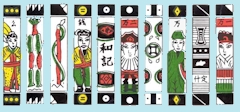
Chinese money cards

Modern domino cards
Cards "as we know them" differ significantly from dominoes in that they consist of a series of numerals in each of four symbolic categories or suits. So do Chinese money cards: their suits are cash (single coins), strings (of cash), hundreds (of strings) and myriads (thousands) of strings. If modern cards derive from Chinese cards, then, it's only to money cards that we can reasonably look. (Mah Jong tiles also have suits and numerals, but date only from the 19th century and clearly derive from money cards.)
Unfortunately for the standard story, money cards themselves are also not firmly attested before the late
Ming period (1590-1644), when they were used for playing a complicated game of tricks and combinations called
ma diao (three-legged horse).

Domino cards, late 19th century
Of course this is far too late for them to have given rise to four-suited
European cards (attested possibly by 1365, definitely by 1377), let alone the Mamluk cards from which they surely derive and the preceding
Ganjifa/Kanjifeh of India and Persia respectively.
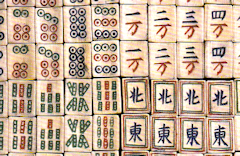
Mah Jong tiles, 1873 or earlier
But we don't have to reject a Chinese origin merely for lack
of positive attestation. For one thing, the fact that ma diao is so complicated suggests that it already had a
substantial history behind it; for another, there is plenty of evidence to show that the Chinese had indeed been
playing games with cards or slips of paper as far back as the 9th century - it's just that the earliest
cards did not, to anyone's certain knowledge, consist of suits or numerals.
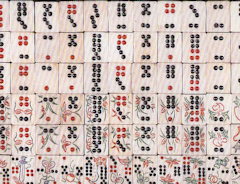
Chinese dominoes for the game of wa hua
("Digging up Flowers"), late 19th century
That ma diao itself is older than late Ming is suggested by a document of 1320. The Department of Punishments of the Yuan Secretariat in Enzhou (in modern Shandong Province) reported that on 17 July 1294 Yen Sengzhu and Zheng Pig-Dog were caught playing cards [zhi pai] and that wood blocks for printing them had been impounded, together with nine of the actual cards. Unfortunately the Department gave no descriptive details, and, since the cards have not been traced, it is impossible to do more than guess that they might have been suited cards, perhaps for playing ma diao. On the basis of this report, however, Lo confidently asserts that "Chinese playing cards date from at least 1294" (Andrew Lo, "The Late Ming Game of Ma diao", in The Playing-card (Journal of the international Playing-Card Society), v.XXIX, No. 3, Nov-Dec 2000, p.115ff).
But even 1294 is still too late for money-suited Chinese cards to have undergone the evolution necessary to produce their presumed European descendants via India and Persia. Surely some of the earlier references to yezi must have been to cards or paper slips with something printed on them, and what could they be if not money-suited cards?
Another answer to that question -
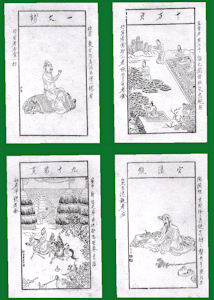
Chen Hongshou (1599-1652):
Drinking cards, c.1651
besides that of cards used in a promotion game also involving dice -
is that they could have been for a drinking or wine game. "Wine-drinking games using cards", says Lo, "can
be traced to games using chou (tallies), zhi riezi (paper cards) or pai (plaques)
at least from the Tang Dynasty onwards." These cards were printed with instructions or forfeits to be followed
by whoever drew them in play. One such card, from the Yuan period (1271-1368), reads:
Card #7: The man from Qi begs for leftovers
Begging for leftovers is truly despicable,
Not satisfied, he goes off elsewhere.
His wife and concubine mock him in turn.
But happily he comes home still wanting to brag.
Instructions: He who gets this order receives an old cup of wine, drinks a little and then
begs for wine and food from the guests. Then he brags. If there are courtesans in the party, they pretend to
be his wife and concubine and scold him. If there are no courtesans, his two neighbours act as wife and concubine.
In short, it seems quite plausible that the yezi played by emperor Muzong on new year's eve 969 was a
wine-drinking game rather than a forerunner of ma diao.
Thus we can only say that the idea of playing games with cards or slips of paper bearing something written or printed on one side only were certainly invented by the Chinese in the late Tang period (9th century), and that cards with suits and numerals appeared by the 13th century (1294). But how, when or even whether they had any bearing on playing cards as such remains unknown. Perhaps more relevant was the Chinese introduction of paper money in 1023.
Games historian John McLeod, of Pagat.com adds: "I do find it very probable that Western suited cards and Chinese money cards had a common origin. Aside from the similarity of some of the suits (cash with coins, strings with batons) which might be coincidence, there is the common idea that the numeral cards rank in the reverse order in some suits. Perhaps even more convincing is the common idea of trick-taking, in which everyone plays a card in turn and the trick is won by the highest card of the suit played by the first player. It is hard to believe that this idea was invented independently in the East and the West, and the suited pack is so well adapted to it that it is also difficult to imagine that either culture developed suited cards first and then imported the idea of trick-taking later, finding that they already had exactly the right sort of cards for it, cards which they had previously been using for some other purpose."
Illustrations mainly from Andrew Lo, "China's Passion for Playing Cards, Dominoes, and Mahjong", in Asian Games: the Art of Contest (The Asia Society, N.Y., pp. 216-231). See also: World of Playing Cards (China) Regional Cards of China and Hong Kong Card games in China Chinese Origin Of Playing Cards by W.H. Wilkinson, The American Anthropologist, Volume VIII, January 1895, Pages 61-78 Literati Culture in Ming Dynasty Drinking Games Using Cards (Andrew Lo, 2008) Thanks to Raymond Lee for alerting me to this, and for sundry corrections.

